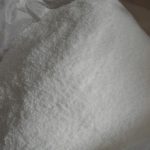The triglyceride 1,2,3-triacetoxypropane is more generally known as triacetin E1518 and glycerin triacetate. It is the triesterof glycerol and acetylating agents, such as acetic acid and acetic anhydride. Though Triacetin E1518 is considered safe, some are convinced it has potentially dangerous health effects.
What Is Triacetin E1518?
Triacetin is a colorless liquid.
Continue Reading
DATEM (diacetyl tartaric acid ester of mono- and diglycerides, also E472e) is an emulsifier primarily used in baking to create a strong gluten network in dough. It is added to crusty breads, such as rye to impart a springy, chewy texture, as well as in the production of biscuits, coffee
Continue Reading
Calcium Stearoyl Lactylate appears as an ivory white powder or lamellar solid. It can be used as an emulsifier and as a preservative. Though Calcium Stearoyl Lactylate’s considered safe, some are convinced it has potentially dangerous health effects.
What Is Calcium Stearoyl Lactylate?
Calcium Stearoyl Lactylate functions to increase toughness, emulsify, improve preservation,
Continue Reading
Stearic acid, a saturated fatty acid, is also known as octadecanoic acid. Though it’s considered safe, some are convinced it has potentially dangerous health effects.
What Is Stearic acid?
Stearic Acid is used in a multitude of products that we use every day like shaving cream, cosmetics, medicines, skincare products, soaps, detergents and candles.
Continue Reading
Sodium hydroxide E524, also known as lye and caustic soda, is an inorganic compound with formula NaOH. Though Sodium hydroxide E524 is considered safe, some are convinced it has potentially dangerous health effects.
What Is Sodium Hydroxide E524?
Sodium Hydroxide (Caustic Soda) is a white flakes or a white granular product or may
Continue Reading
Sodium Bicarbonate E500 is a chemical compound with the formula NaHCO3. It is a salt composed of sodium ions and bicarbonate ions. Though it’s considered safe, some are convinced it has potentially dangerous health effects.
What Is Sodium Bicarbonate E500?
Sodium Bicarbonate E500, known as baking soda, is a chemical leavening agent. This product
Continue Reading
Potassium Chloride (KCl) is a metal halide salt composed of potassium and chloride. Though it’s considered safe, some are convinced it has potentially dangerous health effects.
What Is Potassium Chloride?
Potassium Chloride is a food additive used as a regulator and gelling agent. It is a colorless crystal or a white crystal powder. Potassium
Continue Reading
Modified starch, also called starch derivatives, are prepared by physically, enzymatically, or chemically treating native starch to change its properties. Though it’s considered safe, some are convinced it has potentially dangerous health effects.
What Is Modified Starch?
Modified Starch is a genetically modified variant of common cornstarch. Modified Starch appears as a
Continue Reading
Glycerol E422 is a simple polyol compound. It is a colorless, odorless, viscous liquid that is sweet-tasting and non-toxic. Though Glycerol E422 is considered safe, some are convinced it has potentially dangerous health effects.
What Is Glycerol E422?
Glycerol E422 is a clear, colorless, syrupy liquid with a greasy texture. This product is used
Continue Reading
Ferrous gluconate E579 or Iron(II) gluconate, is a black compound often used as an iron supplement. It is the iron(II) salt of gluconic acid. Though Ferrous gluconate E579 is considered safe, some are convinced it has potentially dangerous health effects.
What Is Ferrous Gluconate E579?
Ferrous Gluconate E579 is an iron nutrition enhancer that
Continue Reading
EDTA also known as Ethylenediaminetetraacetic acid, is a chemical used for both industrial and medical purposes. Though it’s considered safe, some are convinced it has potentially dangerous health effects.
What Is EDTA?
EDTA can be used as a chelating agent; preservative, flavoring and stabilizing agent, as well as a color retention agent in
Continue Reading
Disodium EDTA E386 can be used when there is a chelating agent needed for general use and in food processing. Though Disodium EDTA E386 is considered safe, some are convinced it has potentially dangerous health effects.
What Is Disodium EDTA E386?
EDTA stands for ethylenediaminetetraacetic acid, chemical formula C10H16N2O8. It is primarily
Continue Reading
Calcium sulfate is used in a wide variety of foods. It appears as a coagulant, a firming agent, a leavening chemical, a conditioner, a stabilizer, and a thickening agent. Calcium sulfate can be found in pastas, breads, baking powder, cheese, jellies, candies, and tofu. Though it’s considered safe, some are
Continue Reading
Ammonium Bicarbonate is a white crystalline powder with a weak ammonia odor. It is mainly used as a foaming agent in baked goods such as bread, cookies, and cakes. Though it’s considered safe, some are convinced it has potentially dangerous health effects.
What Is Ammonium Bicarbonate?
Ammonium Bicarbonate is used as a
Continue Reading
Higenamine HCL is used as a nutritional supplement has been generally regarded to be safe. Though it’s considered safe, some are convinced it has potentially dangerous health effects.
What Is Higenamine HCL?
Higenamine is a chemical found in several plants including aconite, Annona squamosa, Nandina domestica (sacred bamboo), and others. Higenamine HCL is
Continue Reading

